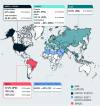A global perspective of the changing epidemiology of invasive fungal disease and real-world experience with the use of isavuconazole
- PMID: 39138063
- PMCID: PMC11382804
- DOI: 10.1093/mmy/myae083
A global perspective of the changing epidemiology of invasive fungal disease and real-world experience with the use of isavuconazole
Abstract
Global epidemiological data show that the incidence of invasive fungal disease (IFD) has increased in recent decades, with the rising frequency of infections caused by Aspergillus and Mucorales order species. The number and variety of patients at risk of IFD has also expanded, owing in part to advances in the treatment of hematologic malignancies and other serious diseases, including hematopoietic stem cell transplantation (HCT) and other therapies causing immune suppression. Isavuconazonium sulfate (active moiety: isavuconazole) is an advanced-generation triazole antifungal approved for the treatment of invasive aspergillosis and mucormycosis that has demonstrated activity against a variety of yeasts, moulds, and dimorphic fungi. While real-world clinical experience with isavuconazole is sparse in some geographic regions, it has been shown to be effective and well tolerated in diverse patient populations, including those with multiple comorbidities who may have failed to respond to prior triazole antifungal therapy. Isavuconazole may be suitable for patients with IFD receiving concurrent QTc-prolonging therapy, as well as those on venetoclax or ruxolitinib. Data from clinical trials are not available to support the use of isavuconazole prophylactically for the prevention of IFD or for the treatment of endemic IFD, such as those caused by Histoplasma spp., but real-world evidence from case studies suggests that it has clinical utility in these settings. Isavuconazole is an option for patients at risk of IFD, particularly when the use of alternative antifungal therapies is not possible because of toxicities, pharmacokinetics, or drug interactions.
Keywords: Fungal epidemiology; antifungal therapy; healthcare resource utilization; invasive fungal disease; isavuconazonium sulfate; real-world.
Plain language summary
This article summarizes the epidemiology and risk factors for IFD, before focusing on the effectiveness and safety of the antifungal agent isavuconazole for treatment of invasive aspergillosis and mucormycosis, and its potential to prevent IFD in specific patient populations.
© The Author(s) 2024. Published by Oxford University Press on behalf of The International Society for Human and Animal Mycology.
Conflict of interest statement
G.R.T. has received grants from Astellas, Cidara, Mundipharma, Melinta, F2G, Mayne, Scynexis, and Merck; and consulting fees from Astellas, Cidara, Mundipharma, Melinta, F2G, Mayne, Scynexis, and Merck; participated on a data safety monitoring board or advisory board for Pfizer.
S.C.-A.C. has received grants from F2G Ltd.; consulting fees from MSD Australia.
W.A.A. has received grants from Pfizer; consulting fees from Pfizer; payment/honoraria from Pfizer and MSD.
K.I. has received grants from Asahi Kasei Pharma Corporation and Sumitomo Dainippon Pharma Co., Ltd.; consulting fees from Asahi Kasei Pharma Corporation; payment and/or honoraria from Asahi Kasei Pharma Corporation, Sumitomo Dainippon Pharma Co., Ltd., Pfizer Japan Inc., and MSD, Co., Inc.
A.L.C. has received grants from The São Paulo Research Foundation (FAPESP: grant number 2021/10599-3) and Knight Therapeutics; consulting fees from ACHE and Eurofarma; payment and/or honoraria from Knight Therapeutics, Gilead, United Medical, and Sandoz; travel/meeting support from Mundipharma, Knight Therapeutics, and Eurofarma; and participated on a data safety monitoring board or advisory board for Mundipharma and Sandoz.
J.M. has received consulting fees from F2G and Mundipharma; payment/honoraria from Gilead Sciences, Mundipharma, and F2G; travel/meeting support from F2G; participated on a data safety monitoring board or advisory board for Gilead Sciences, Mundipharma, and F2G.
Figures


References
-
- Denning DW. Global incidence and mortality of severe fungal disease. Lancet Infect Dis. 2024; 24(7): e428–e438. - PubMed

